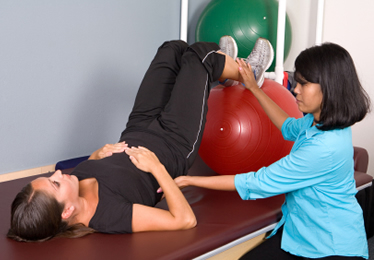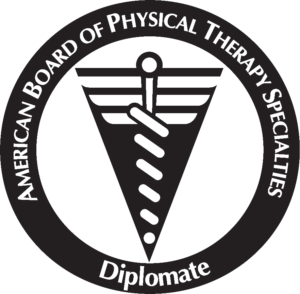Nutrition plays such an important role in our pregnancies and post-partum periods. Breastfeeding requires time…

Would You Benefit From Seeing a Pelvic Pain PT?
Physical Therapists Can Specialize in “Pelvic Floor Rehabilitation?” Wait, What is the Pelvic Floor?
Pelvic floor rehabilitation is becoming increasingly popular, supported by research and proven to be effective in the clinic. Most people believe physical therapists (PTs) only treat orthopedic conditions, such as low back pain, knee injuries, and post-operative situations, like an ACL repair or total knee replacement. However, it is within physical therapist’s scope of practice to also treat urinary and bowel incontinence, pelvic pain, pain with sex, just to name a few. If you respond “yes” to any of the following questions, you may benefit from pelvic floor PT:
- Do you leak urine at various times throughout the day? This can be experienced when coughing, running, laughing, or when you feel like you can’t hold your urine any longer.
- Do you experience pain with sex or with insertion of a tampon?
- Do you experience constipation or fecal incontinence?
- Have you or are you receiving treatment for cancer?
- Do you have pain in the abdomen, pelvis, low back, hips, or groin area that has not improved, even with previous bouts of physical therapy?
- Are you pregnant and want to know the proper way to exercise while pregnant and after delivery of baby?
- Do you have burning type of pain after sitting for long periods of time or with bowel movements?
- Do you have pain in your tailbone region or in pelvis region while running or exercising?
- Have you been or are you pregnant?
- Did you experience any tears muscle tears while giving birth?
- Are you experiencing differences “down there” after you gave birth, such as leaking or pain?
- Have you been diagnosed with endometriosis?
“WHAT?!,” you may be thinking, “that sounds like a lot of non-muscle stuff, so what does the pelvic floor actually entail and how do you treat all of these conditions?”
Most importantly, we work very closely with other medical providers, such as OB/GYN’s, family practice doctors, other physical therapists, and even social workers, psychologists, and psychiatrists to help treat many of these conditions. Most conditions of the pelvic floor are best treated with a multi-disciplinary approach, so we are in communication with many of these providers to ensure you receive optimal care.
What is the pelvic floor?
What in the heck are we looking at here?
Both of these images are from a view from underneath, with the tailbone towards the bottom of the picture and your pubic bone and urethra at the top of the picture. In the first picture, imagine the female lying on her back with her hips and knees bent. All of the red/orange stuff with lines in it are muscles. Yes, you have that many muscles down there that support your bladder, uterus, and other organs. There are 3 layers of pelvic muscles, with the levator ani muscles and coccygeus being most superficial. The function of these pelvic floor muscles should work together to provide a variety of functions that are listed below:
- Support organs, such as bladder and uterus
- Work with diaphragm and deep core muscles for relaxation and core support
- Help with stabilization of SI joint, pelvis, low back, and hip joints
- Contract/relax openings of urethra, rectum and vagina to assist in urination/defecation and to prevent leakage
- Sexual function – to arouse, orgasm, and relax
- Also functions as a sump-pump for the venous and lymphatic systems
To be able to function properly, the pelvic floor muscles need to be strong, have good endurance, and be able to react quickly to various forces, such as coughing or the pounding of the cement while running. They also need to be able to relax fully to decrease tightness in the muscles that can cause pain, to allow for non-painful intercourse, etc.
Great, so all of these muscles I never knew about and I’ve never “worked out” could be causing some serious issues. How can you guys help?
Great question, thanks for asking! 😊 Again, optimal treatment includes a multidisciplinary approach. As physical therapists, our job is to rehabilitate those muscles to perform proper contractions, relaxations, and improve coordination and timeliness of activation of those muscles to decrease pain and improve function in daily life. There are multiple ways a pelvic floor rehabilitation specialist will do these things. Some of them include:
- Improving tissue mobility and decreasing trigger points
-
-
- Trigger points are spots in the muscle that are very painful and can restrict movement and function. This is achieved through manual therapy (massage, trigger point release, fascial release, etc.).
-
- Exercise
-
-
- Not just Kegel’s! The pelvic floor PT will evaluate your ability to activate the proper pelvic floor and deep core muscles and will educate on various exercises to strengthen and improve the coordination of those muscles without having to do 300 Kegel’s a day. The pelvic floor PT can also improve function of neighboring joints and muscles to improve daily function.
-
- Pain management techniques
-
-
- There are various techniques a PT will show you to assist in decreasing the amount of pain. Pain management techniques are very helpful for patients with chronic pain that have never felt any long-lasting pain relief.
-
- Education
-
-
- Education on diet, lifestyle habits, and everyday exercise. There are certain times in life a female’s body goes through changes (pregnancy, menopausal, post-menopausal) that affect hormones and the way our body responds to external variables. Pelvic floor PT’s are highly trained and educated to offer advice and refer to other specialists for more intensive dietary needs.
-
- Many other techniques (biofeedback, balloon technique, bracing, etc.)
If you had an injury, dysfunction, or surgery performed on of any other muscle in the body, you would most likely seek treatment and want to rehab that muscle. The pelvic floor muscles are no different! In our opinion, everyone should be aware of the benefits of pelvic floor rehabilitation and to not be embarrassed to seek treatment to improve daily life, including men! There are many resources out there for you to research more in-depth if wanting more information:
https://pelvicpain.org/patients/patient-education-booklet.aspx
If you have any questions, are experiencing any of these symptoms/dysfunctions, please give us a call to chat with us or to set up an appointment! We offer a free, 15 minute screening to determine if you would benefit from our services. We are commited to providing hope and healing for pelvic floor disorders.
Here are 3 research articles about pelvic floor rehabilitation with incontinence and pelvic floor dysfunction:
- Heilbrun ME, Nygaard IE, Lockhart ME, et al. Correlation between levator ani muscle injuries on MRI and fecal incontinence, pelvic organ prolapse, and urinary incontinence in primiparous women. American journal of obstetrics and gynecology. 2010;202(5):488.e1-488.e6. doi:10.1016/j.ajog.2010.01.002.
- Price N, Dawood R, Jackson S. Pelvic floor exercise for urinary incontinence: A systematic literature review. Maturitas. 2010;67(4):309-315. doi:10.1016/j.maturitas.2010.08.004.
- Hay-Smith J, Dumoulin C. Pelvic floor muscle training versus no treatment, or inactive control treatments, for urinary incontinence in women. Cochrane Database of Systematic Reviews. 2006. doi:10.1002/14651858.cd005654.
- Renee Freeman, SPT




